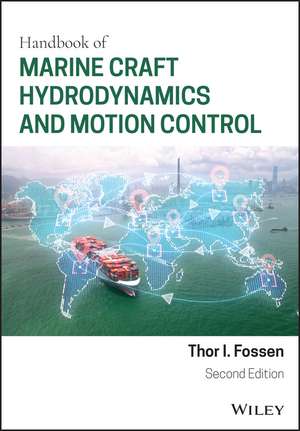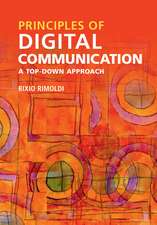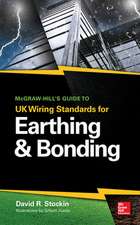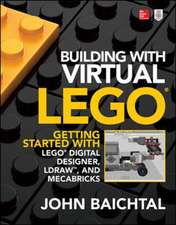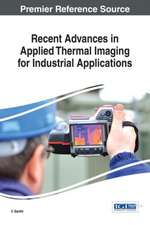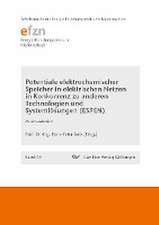Handbook of Marine Craft Hydrodynamics and Motion Control 2nd Edition
Autor TI Fossenen Limba Engleză Hardback – 21 apr 2021
Handbook of Marine Craft Hydrodynamics and Motion Control is an extensive study of the latest research in hydrodynamics, guidance, navigation, and control systems for marine craft. The text establishes how the implementation of mathematical models and modern control theory can be used for simulation and verification of control systems, decision-support systems, and situational awareness systems. Coverage includes hydrodynamic models for marine craft, models for wind, waves and ocean currents, dynamics and stability of marine craft, advanced guidance principles, sensor fusion, and inertial navigation.
This important book includes the latest tools for analysis and design of advanced GNC systems and presents new material on unmanned underwater vehicles, surface craft, and autonomous vehicles. References and examples are included to enable engineers to analyze existing projects before making their own designs, as well as MATLAB scripts for hands-on software development and testing. Highlights of this Second Edition include:
- Topical case studies and worked examples demonstrating how you can apply modeling and control design techniques to your own designs
- A Github repository with MATLAB scripts (MSS toolbox) compatible with the latest software releases from Mathworks
- New content on mathematical modeling, including models for ships and underwater vehicles, hydrostatics, and control forces and moments
- New methods for guidance and navigation, including line-of-sight (LOS) guidance laws for path following, sensory systems, model-based navigation systems, and inertial navigation systems
MSS toolbox: https: //github.com/cybergalactic/mss
Lecture notes: https: //www.fossen.biz/wiley
Author's home page: https: //www.fossen.biz
Preț: 1083.82 lei
Preț vechi: 1484.69 lei
-27% Nou
Puncte Express: 1626
Preț estimativ în valută:
207.39€ • 225.98$ • 174.76£
207.39€ • 225.98$ • 174.76£
Carte tipărită la comandă
Livrare economică 23 aprilie-07 mai
Preluare comenzi: 021 569.72.76
Specificații
ISBN-13: 9781119575054
ISBN-10: 1119575052
Pagini: 736
Dimensiuni: 170 x 244 x 40 mm
Greutate: 1.14 kg
Ediția:2nd Edition
Editura: Wiley
Locul publicării:Chichester, United Kingdom
ISBN-10: 1119575052
Pagini: 736
Dimensiuni: 170 x 244 x 40 mm
Greutate: 1.14 kg
Ediția:2nd Edition
Editura: Wiley
Locul publicării:Chichester, United Kingdom
Notă biografică
Thor I. Fossen is a naval architect, cyberneticist, and Professor of Guidance, Navigation, and Control at the Norwegian University of Science and Technology. He received his MS in Naval Architecture and his PhD in Engineering and Cybernetics from the Norwegian Institute of Technology. Fossen was elected to the Norwegian Academy of Technological Sciences in 1998 and became an Institute of Electrical and Electronics Engineers (IEEE) Fellow in 2016.
Cuprins
About the Author xvii Preface xix List of Tables xxiii Part One Marine Craft Hydrodynamics 1 Introduction to Part I 3 Degrees of Freedom and Motion of a Marine Craft 5 1.1 Classification of Models 6 1.2 The Classical Models in Naval Architecture 8 1.2.1 Maneuvering Theory 10 1.2.2 Seakeeping Theory 12 1.2.3 Unified Theory 14 1.3 Fossen's Robot-inspired Model for Marine Craft 14 Component Form 14 Matrix-vector Representation 14 Component Form Versus the Matrix-vector Representation 15 2 Kinematics 17 2.1 Kinematic Preliminaries 18 2.1.1 Reference Frames 18 2.1.2 Body-fixed Reference Points 21 2.1.3 Generalized Coordinates 22 2.2 Transformations Between BODY and NED 23 2.2.1 Euler Angle Transformation 26 2.2.2 Unit Quaternions 32 2.2.3 Unit Quaternion from Euler Angles 38 2.2.4 Euler Angles from a Unit Quaternion 38 2.3 Transformations Between ECEF and NED 39 2.3.1 Longitude and Latitude Rotation Matrix 40 2.3.2 Longitude, Latitude and Height from ECEF Coordinates 41 2.3.3 ECEF Coordinates from Longitude, Latitude and Height 44 2.4 Transformations between ECEF and Flat-Earth Coordinates 45 2.4.1 Longitude, Latitude and Height from Flat-Earth Coordinates 45 2.4.2 Flat-Earth Coordinates from Longitude, Latitude and Height 46 2.5 Transformations Between BODY and FLOW 47 2.5.1 Definitions of Heading, Course and Crab Angles 47 2.5.2 Definitions of Angle of Attack and Sideslip Angle 49 2.5.3 Flow-axes Rotation Matrix 51 3 Rigid-body Kinetics 55 3.1 Newton-Euler Equations of Motion about the CG 56 Euler's First and Second Axioms 56 3.1.1 Translational Motion About the CG 58 3.1.2 Rotational Motion About the CG 59 3.1.3 Equations of motion About the CG 60 3.2 Newton-Euler Equations of Motion About the CO 60 3.2.1 Translational Motion About the CO 61 3.2.2 Rotational Motion About the CO 61 3.3 Rigid-body Equations of Motion 63 3.3.1 Nonlinear 6-DOF Rigid-body Equations of Motion 63 3.3.2 Linearized 6-DOF Rigid-body Equations of Motion 69 4 Hydrostatics 71 4.1 Restoring Forces for Underwater Vehicles 71 4.1.1 Hydrostatics of Submerged Vehicles 71 4.2 Restoring Forces for Surface Vessels 74 4.2.1 Hydrostatics of Floating Vessels 74 4.2.2 Linear (Small Angle) Theory for Boxed-shaped Vessels 77 4.2.3 Computation of Metacenter Heights for Surface Vessels 79 4.3 Load Conditions and Natural Periods 82 4.3.1 Decoupled Computation of Natural Periods 82 4.3.2 Computation of Natural Periods in a 6-DOF Coupled System 84 4.3.3 Natural Periods as a Function of Load Condition 87 4.3.4 Free-surface Effects 89 4.3.5 Payload Effects 90 4.4 Seakeeping Analysis 90 4.4.1 Harmonic Oscillator with Sinusoidal Forcing 90 4.4.2 Steady-state Heave, Roll and Pitch Responses in Regular Waves 92 4.4.3 Explicit Formulae for Boxed-shaped Vessels in Regular Waves 94 4.4.4 Case Study: Resonances in the Heave, Roll and Pitch Modes 96 4.5 Ballast Systems 97 4.5.1 Static Conditions for Trim and Heel 99 4.5.2 Automatic Ballast Control Systems 102 5 Seakeeping Models 105 5.1 Hydrodynamic Concepts and Potential Theory 106 5.1.1 Numerical Approaches and Hydrodynamic Codes 108 5.2 Seakeeping and Maneuvering Kinematics 110 5.2.1 Seakeeping Reference Frame 110 5.2.2 Transformation Between BODY and SEAKEEPING 111 5.3 The Classical Frequency-domain Model 114 5.3.1 Frequency-dependent Hydrodynamic Coefficients 115 5.3.2 Viscous Damping 118 5.3.3 Response Amplitude Operators 122 5.4 Time-domain Models including Fluid Memory Effects 122 5.4.1 Cummins Equation in SEAKEEPING Coordinates 123 5.4.2 Linear Time-domain Seakeeping Equations in BODY Coordinates 126 5.4.3 Nonlinear Unified Seakeeping and Maneuvering Model with Fluid Memory Effects 129 5.5 Identification of Fluid Memory Effects 131 5.5.1 Frequency-domain Identification Using the MSS FDI Toolbox 131 6 Maneuvering Models 135 6.1 Rigid-body Kinetics 137 6.2 Potential Coefficients 137 6.2.1 Frequency-independent Added Mass and Potential Damping 139 6.2.2 Extension to 6-DOF Models 140 6.3 Added Mass Forces in a Rotating Coordinate System 141 6.3.1 Lagrangian Mechanics 142 6.3.2 Kirchhoff's Equation 143 6.3.3 Added Mass and Coriolis-Centripetal Matrices 143 6.4 Dissipative Forces 148 6.4.1 Linear Damping 150 6.4.2 Nonlinear Surge Damping 151 6.4.3 Cross-flow Drag Principle 154 6.5 Ship Maneuvering Models (3 DOFs) 155 6.5.1 Nonlinear Equations of Motion 155 6.5.2 Nonlinear Maneuvering Model Based on Surge Resistance and Cross-flow Drag 158 6.5.3 Nonlinear Maneuvering Model Based on Second-order Modulus Functions 159 6.5.4 Nonlinear Maneuvering Model Based on Odd Functions 161 6.5.5 Linear Maneuvering Model 163 6.6 Ship Maneuvering Models Including Roll (4 DOFs) 165 6.6.1 The Nonlinear Model of Son and Nomoto 172 6.6.2 The Nonlinear Model of Blanke and Christensen 173 6.7 Low-Speed Maneuvering Models for Dynamic Positioning (3 DOFs) 175 6.7.1 Current Coefficients 175 6.7.2 Nonlinear DP Model Based on Current Coefficients 179 6.7.3 Linear Time-varying DP Model 180 7 Autopilot Models for Course and Heading Control 183 7.1 Autopilot Models for Course Control 184 7.1.1 State-space Model for Course Control 184 7.1.2 Course Angle Transfer Function 185 7.2 Autopilot Models for Heading Control 186 7.2.1 Second-order Nomoto Model 186 7.2.2 First-order Nomoto Model 188 7.2.3 Nonlinear Extensions of Nomoto's Model 190 7.2.4 Pivot Point 192 8 Models for Underwater Vehicles 195 8.1 6-DOF Models for AUVs and ROVs 195 8.1.1 Equations of Motion Expressed in BODY 195 8.1.2 Equations of Motion Expressed in NED 197 8.1.3 Properties of the 6-DOF Model 198 8.1.4 Symmetry Considerations of the System Inertia Matrix 200 8.2 Longitudinal and Lateral Models for Submarines 201 8.2.1 Longitudinal Subsystem 202 8.2.2 Lateral Subsystem 204 8.3 Decoupled Models for "Flying Underwater Vehicles" 205 8.3.1 Forward Speed Subsystem 206 8.3.2 Course Angle Subsystem 206 8.3.3 Pitch-Depth Subsystem 207 8.4 Cylinder-Shaped Vehicles and Myring-type Hulls 208 Myring-type Hull 209 8.4.1 Spheroid Approximation 210 8.5 Spherical-Shaped Vehicles 214 9 Control Forces and Moments 217 9.1 Propellers as Thrust Devices 217 9.1.1 Fixed-pitch Propeller 217 9.1.2 Controllable-pitch Propeller 220 9.2 Ship Propulsion Systems 225 9.2.1 Podded Propulsion Units 225 9.2.2 Prime Mover System 227 9.3 USV and Underwater Vehicle Propulsion Systems 228 9.3.1 Propeller Shaft Speed Models 229 9.3.2 Motor Armature Current Control 230 9.3.3 Motor Speed Control 232 9.4 Thrusters 233 9.4.1 Tunnel Thrusters 233 9.4.2 Azimuth Thrusters 234 9.5 Rudder in the Propeller Slipstream 236 9.5.1 Rudder Forces and Moment 237 9.5.2 Steering Machine Dynamics 240 9.6 Fin Stabilizators 243 9.6.1 Lift and Drag Forces on Fins 244 9.6.2 Roll Moment Produced by Symmetrical Fin Stabilizers 245 9.7 Underwater Vehicle Control Surfaces 245 9.7.1 Rudder 247 9.7.2 Dive Planes 248 9.8 Control Moment Gyroscope 249 9.8.1 Ship Roll Gyrostabilizer 249 9.8.2 Control Moment Gyros for Underwater Vehicles 252 9.9 Moving Mass Actuators 258 10 Environmental Forces and Moments 261 10.1 Wind Forces and Moments 263 10.1.1 Wind Forces and Moments on Marine Craft at Rest 263 10.1.2 Wind Forces and Moments on Moving Marine Craft 265 10.1.3 Wind Coefficients Based on Helmholtz-Kirchhoff Plate Theory 266 10.1.4 Wind Coefficients for Merchant Ships 269 10.1.5 Wind Coefficients for Very Large Crude Carriers 271 10.1.6 Wind Coefficients for Large Tankers and Medium-sized Ships 272 10.1.7 Wind Coefficients for Moored Ships and Floating Structures 272 10.2 Wave Forces and Moments 274 10.2.1 Sea-state Descriptions 275 10.2.2 Wave Spectra 276 10.2.3 Wave Amplitude Response Model 287 10.2.4 Force RAOs 290 10.2.5 Motion RAOs 293 10.2.6 State-space Models for Wave Response Simulation 296 10.3 Ocean Current Forces and Moments 300 10.3.1 3D Irrotational Ocean Current Model 303 10.3.2 2D Irrotational Ocean Current Model 304 Part Two Motion Control 11 Introduction to Part II 309 11.1 Guidance, Navigation and Control Systems 310 11.1.1 Historical Remarks 312 11.1.2 Autopilots 314 11.1.3 Dynamic Positioning and Position Mooring Systems 315 11.1.4 Waypoint Tracking and Path-following Control Systems 316 11.2 Control Allocation 316 11.2.1 Propulsion and Actuator Models 318 11.2.2 Unconstrained Control Allocation 322 11.2.3 Constrained Control Allocation 324 12 Guidance Systems 331 12.1 Trajectory Tracking 333 Trajectory-tracking Control 333 12.1.1 Reference Models for Trajectory Generation 334 12.1.2 Trajectory Generation using a Marine Craft Simulator 339 12.1.3 Optimal Trajectory Generation 340 12.2 Guidance Laws for Target Tracking 341 12.2.1 Line-of-sight Guidance Law 342 12.2.2 Pure-pursuit Guidance Law 343 12.2.3 Constant Bearing Guidance Law 344 12.3 Linear Design Methods for Path Following 346 12.3.1 Waypoints 346 12.3.2 Path Generation using Straight Lines and Inscribed Circles 347 12.3.3 Straight-line Paths Based on Circles of Acceptance 349 12.3.4 Path Generation using Dubins Path 351 12.3.5 Transfer Function Models for Straight-line Path Following 352 12.4 LOS Guidance Laws for Path Following using Course Autopilots 353 12.4.1 Vector-field Guidance Law 354 12.4.2 Proportional LOS Guidance Law 356 12.4.3 Lookahead- and Enclosure-based LOS Steering 359 12.4.4 Integral LOS 361 12.5 LOS Guidance Laws for Path Following using Heading Autopilots 363 12.5.1 Crab Angle Compensation by Direct Measurements 363 12.5.2 Integral LOS 364 12.6 Curved-Path Path Following 365 12.6.1 Path Generation using Interpolation Methods 366 12.6.2 Proportional LOS Guidance Law for Curved Paths 378 12.6.3 Path-following using Serret-Frenet Coordinates 380 12.6.4 Case Study: Path-following Control using Serret-Frenet Coordinates 384 13 Model-based Navigation Systems 387 13.1 Sensors for Marine Craft 387 13.1.1 GNSS Position 388 13.1.2 GNSS Heading 389 13.1.3 Magnetic Compass 390 13.1.4 Gyrocompass 390 13.2 Wave Filtering 391 13.2.1 Low-pass Filtering 393 13.2.2 Cascaded Low-pass and Notch Filtering 396 13.2.3 Wave-frequency Estimation 397 13.3 Fixed-gain Observer Design 403 13.3.1 Observability 403 13.3.2 Luenberger Observer 405 13.3.3 Case Study: Luenberger Observer for Heading Autopilot 406 13.4 Kalman Filter Design 408 13.4.1 Discrete-time Kalman Filter 408 13.4.2 Discrete-time Extended Kalman Filter 411 13.4.3 Modification for Euler Angles to Avoid Discontinuous Jumps 412 13.4.4 Modification for Asynchronous Measurement Data 415 13.4.5 Case Study: Kalman Filter Design for Heading Autopilots 416 13.4.6 Case Study: Kalman Filter for Dynamic Positioning Systems 419 13.5 Passive Observer Design 424 13.5.1 Case Study: Passive Observer for Dynamic Positioning using GNSS and Compass Measurements 424 13.5.2 Case Study: Passive Observer for Heading Autopilots using only Compass Measurements 433 13.5.3 Case Study: Passive Observer for Heading Autopilots using both Compass and Angular Rate Sensor Measurements 441 14 Inertial Navigation Systems 443 14.1 Inertial Measurement Unit 444 14.1.1 Attitude Rate Sensors 446 14.1.2 Accelerometers 446 14.1.3 Magnetometer 449 14.2 Attitude Estimation 451 14.2.1 Static Mapping from Specific Force to Roll and Pitch Angles 451 14.2.2 Vertical Reference Unit (VRU) Transformations 452 14.2.3 Nonlinear Attitude Observer using Reference Vectors 453 14.3 Direct Filters for Aided INS 457 14.3.1 Fixed-gain Observer using Attitude Measurements 458 14.3.2 Direct Kalman Filter using Attitude Measurements 462 14.3.3 Direct Kalman Filter with Attitude Estimation 465 14.4 Indirect Filters for Aided INS 467 14.4.1 Introductory Example 469 14.4.2 Error-state Kalman Filter using Attitude Measurements 472 14.4.3 Error-state Extended Kalman Filter with Attitude Estimation 480 15 Motion Control Systems 493 15.1 Open-Loop Stability and Maneuverability 494 15.1.1 Straight-line, Directional and Positional Motion Stability 495 15.1.2 Maneuverability 504 15.2 Autopilot Design Using Successive Loop Closure 516 15.2.1 Successive Loop Closure 516 15.2.2 Case Study: Heading Autopilot for Marine Craft 518 15.2.3 Case Study: Path-following Control System for Marine Craft 519 15.2.4 Case Study: Diving Autopilot for Underwater Vehicles 521 15.3 PID Pole-Placement Algorithms 523 15.3.1 Linear Mass-Damper-Spring Systems 523 15.3.2 SISO Linear PID Control 527 15.3.3 MIMO Nonlinear PID Control 529 15.3.4 Case Study: Heading Autopilot for Marine Craft 532 15.3.5 Case Study: LOS Path-following Control for Marine Craft 539 15.3.6 Case Study: Dynamic Positioning System for Surface Vessels 541 15.3.7 Case Study: Position Mooring System for Surface Vessels 546 16 Advanced Motion Control Systems 551 Preview of the Chapter 551 16.1 Linear-quadratic Optimal Control 552 16.1.1 Linear-quadratic Regulator 552 16.1.2 LQR Design for Trajectory Tracking and Integral Action 554 16.1.3 General Solution of the LQ Trajectory-tracking Problem 556 16.1.4 Operability and Motion Sickness Incidence Criteria 562 16.1.5 Case Study: Optimal Heading Autopilot for Marine Craft 564 16.1.6 Case Study: Optimal DP System for Surface Vessels 568 16.1.7 Case Study: Optimal Rudder-roll Damping Systems for Ships 572 16.1.8 Case Study: Optimal Fin and RRD Systems for Ships 581 16.2 State Feedback Linearization 582 16.2.1 Decoupling in the BODY Frame (velocity control) 583 16.2.2 Decoupling in the NED Frame (Position and Attitude Control) 584 16.2.3 Case Study: Speed Control Based on Feedback Linearization 586 16.2.4 Case Study: Autopilot Based on Feedback Linearization 587 16.3 Integrator Backstepping 588 16.3.1 A Brief History of Backstepping 588 16.3.2 The Main Idea of Integrator Backstepping 589 16.3.3 Backstepping of SISO Mass-Damper-Spring Systems 596 16.3.4 Integral Action by Constant Parameter Adaptation 599 16.3.5 Integrator Augmentation Technique 601 16.3.6 Case Study: Backstepping Design for Mass-Damper-Spring 604 16.3.7 Case Study: Backstepping Design for Robot Manipulators 606 16.3.8 Case Study: Backstepping Design for Surface Craft 608 16.3.9 Case Study: Autopilot Based on Backstepping 612 16.3.10 Case Study: Path-following Controller for Underactuated Marine Craft 613 16.3.11 Case Study: Weather Optimal Position Control 618 16.4 Sliding Mode Control 633 16.4.1 Conventional Integral SMC for Second-order Systems 636 16.4.2 Conventional Integral SMC for Third-order Systems 639 16.4.3 Super-twisting Adaptive Sliding Mode Control 639 16.4.4 Case Study: Heading Autopilot Based on Conventional Integral SMC 641 16.4.5 Case Study: Depth Autopilot for Diving Based on Conventional Integral SMC 645 16.4.6 Case Study: Heading Autopilot Based on the Adaptive-gain Super Twisting Algorithm 648 Part Three Appendices A Nonlinear Stability Theory 653 A.1 Lyapunov Stability for Autonomous Systems 653 A.1.1 Stability and Convergence 653 A.1.2 Lyapunov's Direct Method 655 A.1.3 Krasovskii-LaSalle's Theorem 656 A.1.4 Global Exponential Stability 657 A.2 Lyapunov Stability of Non-autonomous Systems 658 A.2.1 BarbØalat's Lemma 658 A.2.2 LaSalle-Yoshizawa's Theorem 658 A.2.3 On USGES of Proportional Line-of-sight Guidance Laws 659 A.2.4 UGAS when Backstepping with Integral Action 660 B Numerical Methods 663 B.1 Discretization of Continuous-time Systems 663 B.1.1 State-space Models 663 B.1.2 Computation of the Transition Matrix 665 B.2 Numerical Integration Methods 665 B.2.1 Euler's Method 666 B.2.2 Adams-Bashford's Second-order Method 667 B.2.3 Runge-Kutta Second-order Method 668 B.2.4 Runge-Kutta Fourth-order Method 668 B.3 Numerical Differentiation 668 C Model Transformations 671 C.1 Transforming the Equations of Motion to an Arbitrarily Point 671 C.1.1 System Transformation Matrix 671 C.1.2 Equations of Motion About an Arbitrarily Point 673 C.2 Matrix and Vector Transformations 674 D Nondimensional Equations of Motion 677 D.1 Non-dimensionalization 677 D.1.1 Non-dimensional Hydrodynamic Coefficients 678 D.1.2 Non-dimensional Nomoto Models 679 D.1.3 Non-dimensional Maneuvering Models 680 D.2 6-DOF Procedure for Non-dimensionalization 680 References 683 Index 703
